1998 CHEVROLET ASTRO manual transmission
[x] Cancel search: manual transmissionPage 109 of 414
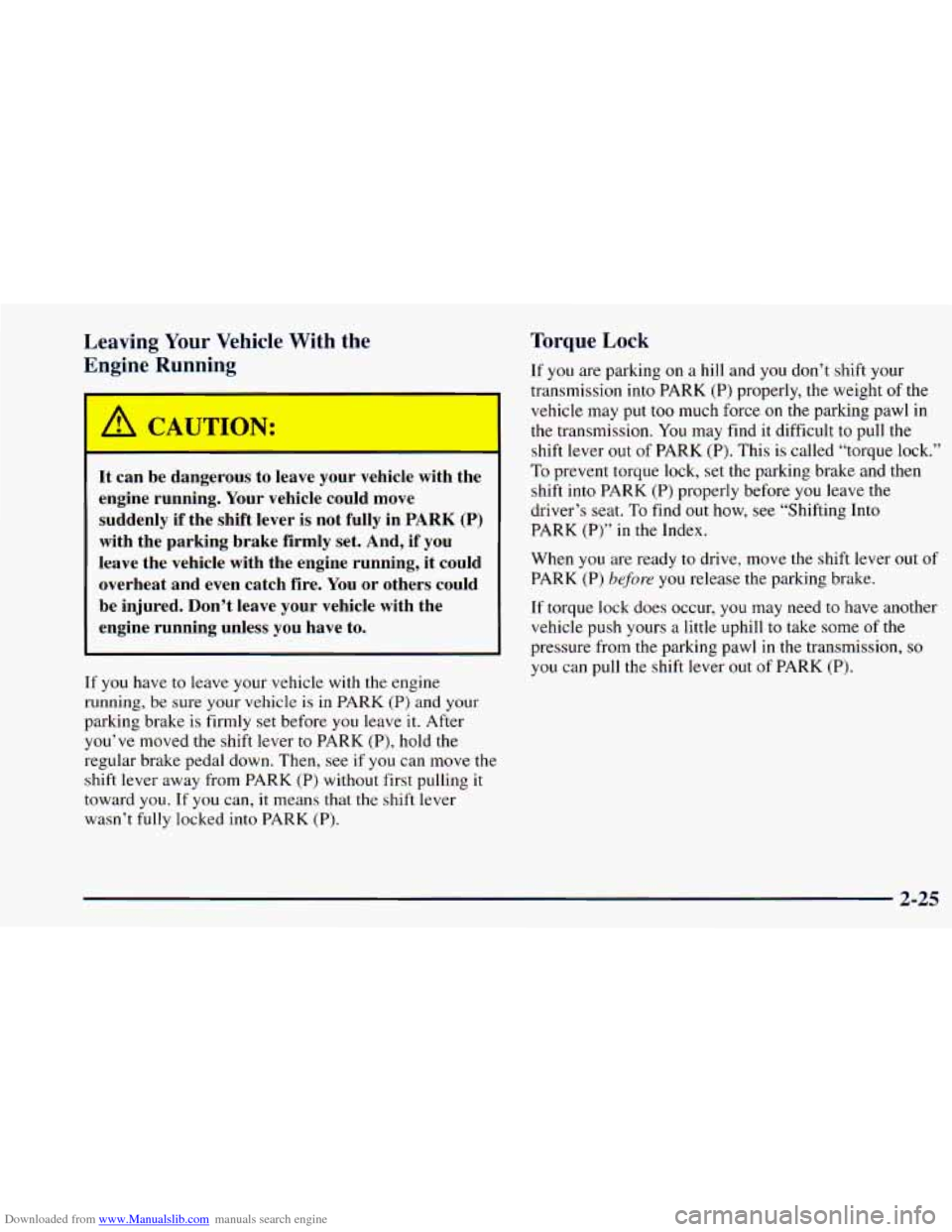
Downloaded from www.Manualslib.com manuals search engine Leaving Your Vehicle With the
Engine Running
-
A CAUTION:
It can be dangerous to leave your vehicle with the
engine running. Your vehicle could move
suddenly if the shift lever is not fully in PARK
(P)
with the parking brake firmly set. And, if you
leave the vehicle with the engine running, it could overheat and even catch fire. You or others could
be injured. Don’t leave your vehicle with the
engine running unless you have to.
If you have to leave your vehicle with the engine
running,
be sure your vehicle is in PARK (P) and your
parking brake is firmly set before you leave
it. After
you’ve moved the shift lever to PARK (P), hold
the
regular brake pedal down. Then, see if you can move the
shift lever away from PARK
(P) without first pulling it
toward you.
If you can, it means that the shift lever
wasn’t fully locked into PARK
(P).
Torque Lock
If you are parking on a hill and you don’t shift your
transmission into PARK
(P) properly, the weight of the
vehicle may put
too much force on the parking pawl in
the transmission. You may find it difficult to pull
the
shift lever out of PARK (P). This is called “torque lock.”
To prevent torque lock, set the parking brake and then
shift
into PARK (P) properly before you leave the
driver’s seat.
To find out how, see “Shifting Into
PARK (P)”
in the Index.
When
you are ready to drive, move the shift lever out of
PARK
(P) before you release the parking brake.
If torque lock does occur, you may need to have another
vehicle push yours a little uphill to take some of
the
pressure from the parking pawl in the transmission, so
you can pull the shift lever out of PARK (P).
2-25
Page 110 of 414
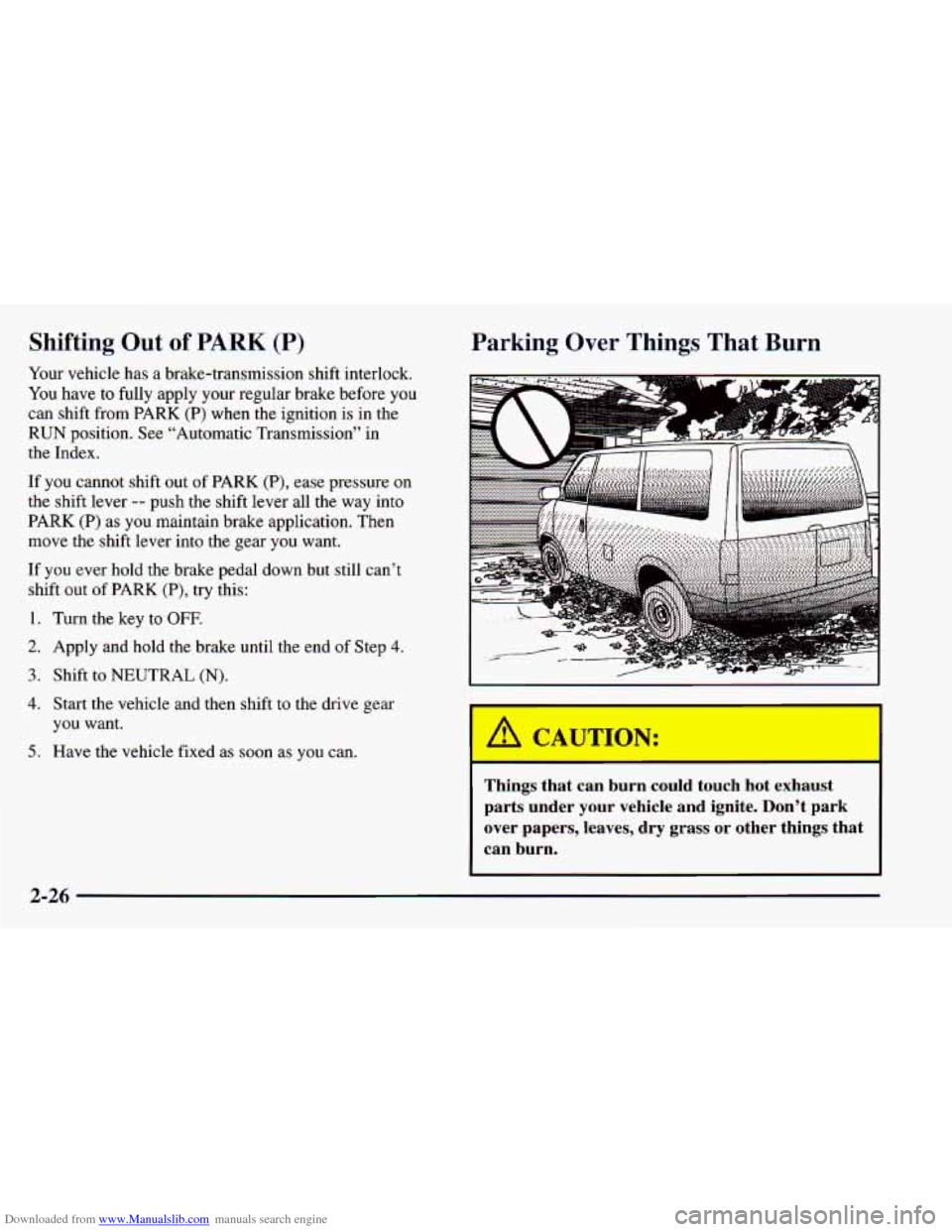
Downloaded from www.Manualslib.com manuals search engine Shifting Out of PARK (P)
Your vehicle has a brake-transmission shift interlock.
You have
to fully apply your regular brake before you
can shift from PARK (P) when the ignition is in the
RUN position. See "Automatic Transmission" in
the Index.
If you cannot shift out of PARK (P), ease pressure on
the shift lever
-- push the shift lever all the way into
PARK
(P) as you maintain brake application. Then
move the shift lever into the gear you want.
If you ever hold the brake pedal down but still can't
shift out of PARK
(P), try this:
1. Turn the key to OFF.
2. Apply and hold the brake until the end of Step 4.
3. Shift to NEUTRAL (N).
4. Start the vehicle and then shift to the drive gear
you want.
5. Have the vehicle fixed as soon as you can.
Parking Over Things That Burn
I A CAUTION:
Y
Things that can burn could touch hot exhaust
parts under your vehicle and ignite. Don't park
over papers, leaves, dry grass or other things that
can burn.
2-26
Page 136 of 414
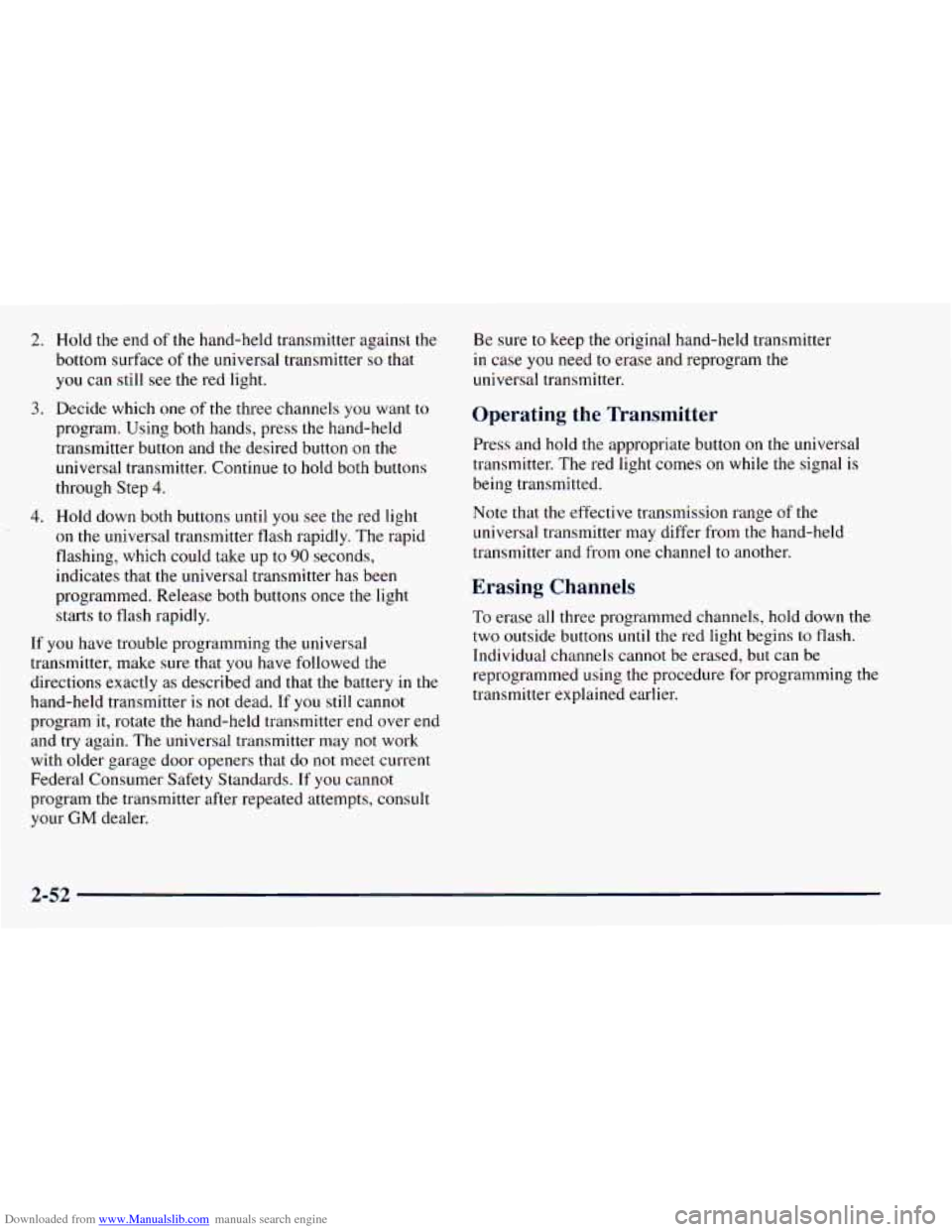
Downloaded from www.Manualslib.com manuals search engine 2.
3.
4.
Hold the end of the hand-held transmitter against the
bottom surface of the universal transmitter so that
you can still see the red light.
Decide which one
of the three channels you want to
program. Using both hands, press the hand-held
transmitter button and the desired button on
the
universal transmitter. Continue to hold both buttons
through Step
4.
Hold down both buttons until you see the red light
on the universal transmitter flash rapidly. The rapid
flashing, which could take up
to 90 seconds,
indicates that the universal transmitter has been
programmed. Release both buttons once the light
starts to flash rapidly.
If
you have trouble programming the universal
transmitter, make sure that
you have followed the
directions exactly as described and
that the battery in the
hand-held transmitter is not dead. If you still cannot
program it, rotate
the hand-held transmitter end over end
and
try again. The universal transmitter may not work
with older garage door openers that
do not meet current
Federal Consumer Safety Standards. If you cannot
program
the transmitter after repeated attempts, consult
your
GM dealer. Be sure
to keep the original hand-held transmitter
in case you need
to erase and reprogram the
universal transmitter.
Operating the Tran I -:--. - r
Press and hold the appropriate button on the universal
transmitter. The red light comes
on while the signal is
being transmitted.
Note that the effective transmission range of the
universal transmitter may differ from the hand-held
transmitter and from one channel to another.
Erasing Channels
To erase all three programmed channels, hold down the
two outside buttons until the red light begins to flash.
Individual channels cannot be erased, but can be
reprogrammed using the procedure for programming the
transmitter explained earlier.
.. .
2-52
Page 139 of 414
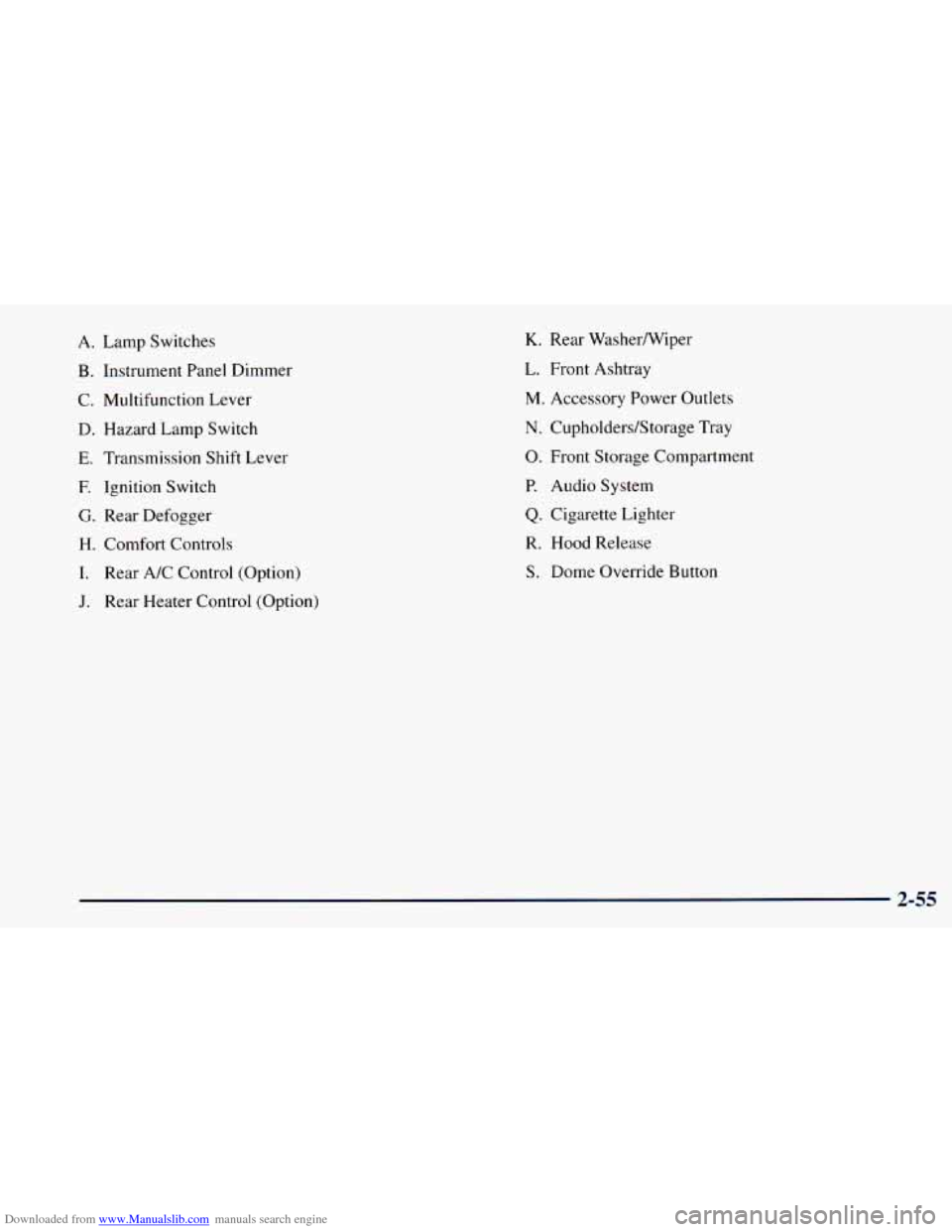
Downloaded from www.Manualslib.com manuals search engine A. Lamp Switches
B. Instrument Panel Dimmer
C. Multifunction Lever
D. Hazard Lamp Switch
E. Transmission Shift Lever
E Ignition Switch
G. Rear Defogger
H. Comfort Controls
I. Rear A/C Control (Option)
J. Rear Heater Control (Option)
K. Rear Washermiper
L. Front Ashtray
M. Accessory Power Outlets
N. Cupholders/Storage Tray
0. Front Storage Compartment
P. Audio System
Q. Cigarette Lighter
R. Hood Release
S. Dome Override Button
2-55
Page 205 of 414

Downloaded from www.Manualslib.com manuals search engine 1
’ Hill and Mountain Roads
Driving on steep hills or mountains is different from
driving in flat or rolling terrain.
If you drive regularly in steep country, or if you’re
planning to visit there, here
are some tips that can make
your trips safer and more enjoyable.
0
0
Keep your vehicle in good shape. Check all fluid
levels and also the brakes, tires, cooling system and
transmission. These parts can work hard on
mountain roads.
Know how to go down hills. The most important
thing
to know is this: let your engine do some of the
slowing down. Shift to a lower gear when you go
down a steep or long hill.
I A CAUTION:
If you don’t shift down, your brakes could get so
hot that they wouldn’t work well. You would then
have poor braking or even none going down
a
hill. You could crash. Shift down to let your
engine assist your brakes on a steep
downhill slope.
4-21
Page 206 of 414
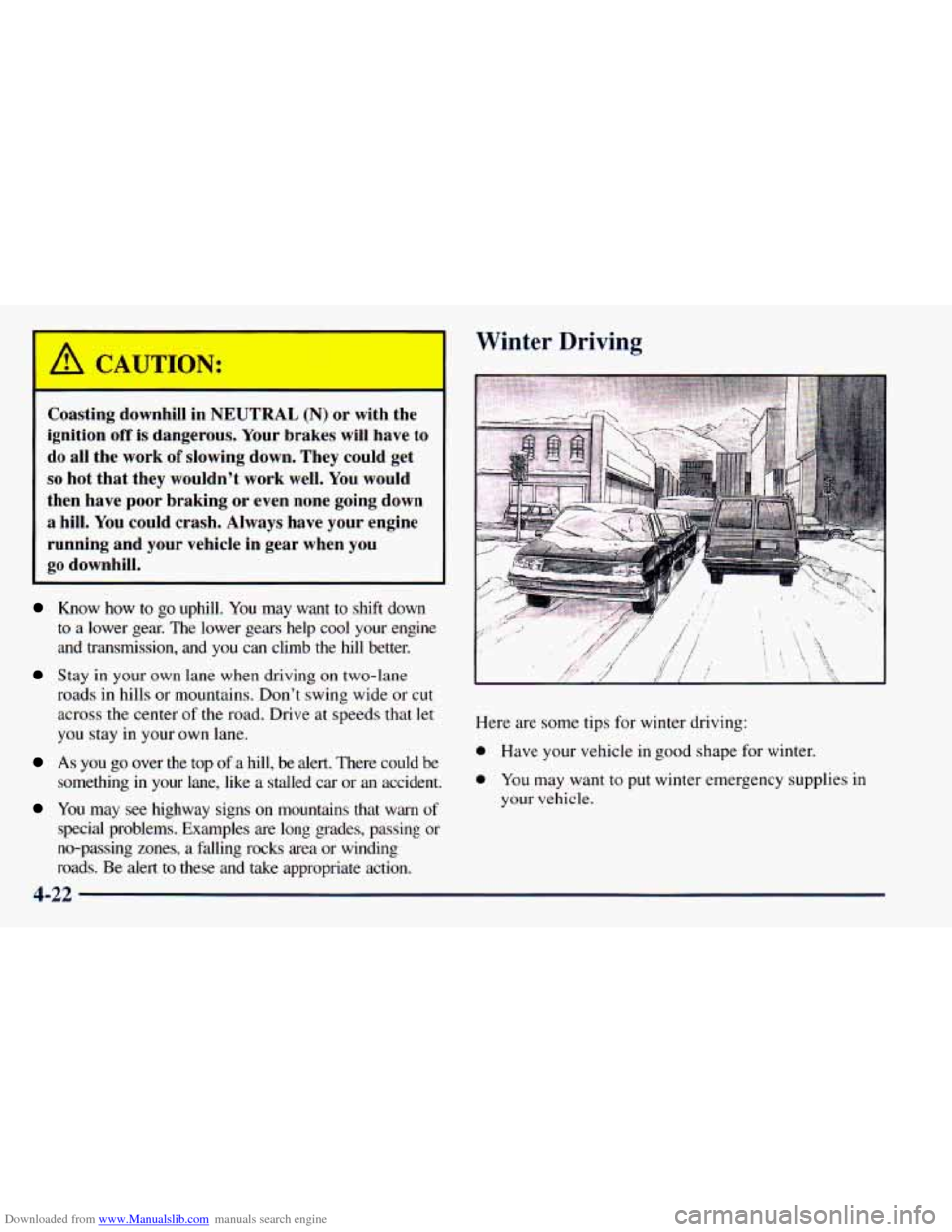
Downloaded from www.Manualslib.com manuals search engine Winter Driving
Coasting downhill in NEUTRAL (N) or with the
ignition
off is dangerous. Your brakes will have to
do all the work of slowing down. They could get
so hot that they wouldn't work well. You would
then have poor braking or even none going down
a hill. You could crash. Always have your engine
running and your vehicle in gear when you
go downhill.
Know how to go uphill. You may want to shift down
to a lower gear. The lower gears help cool your engine
and transmission, and
you can climb the hill better.
Stay in your own lane when driving on two-lane
roads in hills or mountains. Don't swing wide or cut
across
the center of the road. Drive at speeds that let
you stay in your own lane.
As you go over the top of a hill, be alert. There could be
something in your lane, like a stalled
car or an accident.
You may see highway signs on mountains that warn of
special problems. Examples are long grades, passing or
no-passing zones,
a falling rocks area or winding
roads. Be alert
to these and take appropriate action. Here
are
some tips for winter driving:
0 Have your vehicle in good shape for winter.
0 You may want to put winter emergency supplies in
your vehicle.
4-22
Page 213 of 414
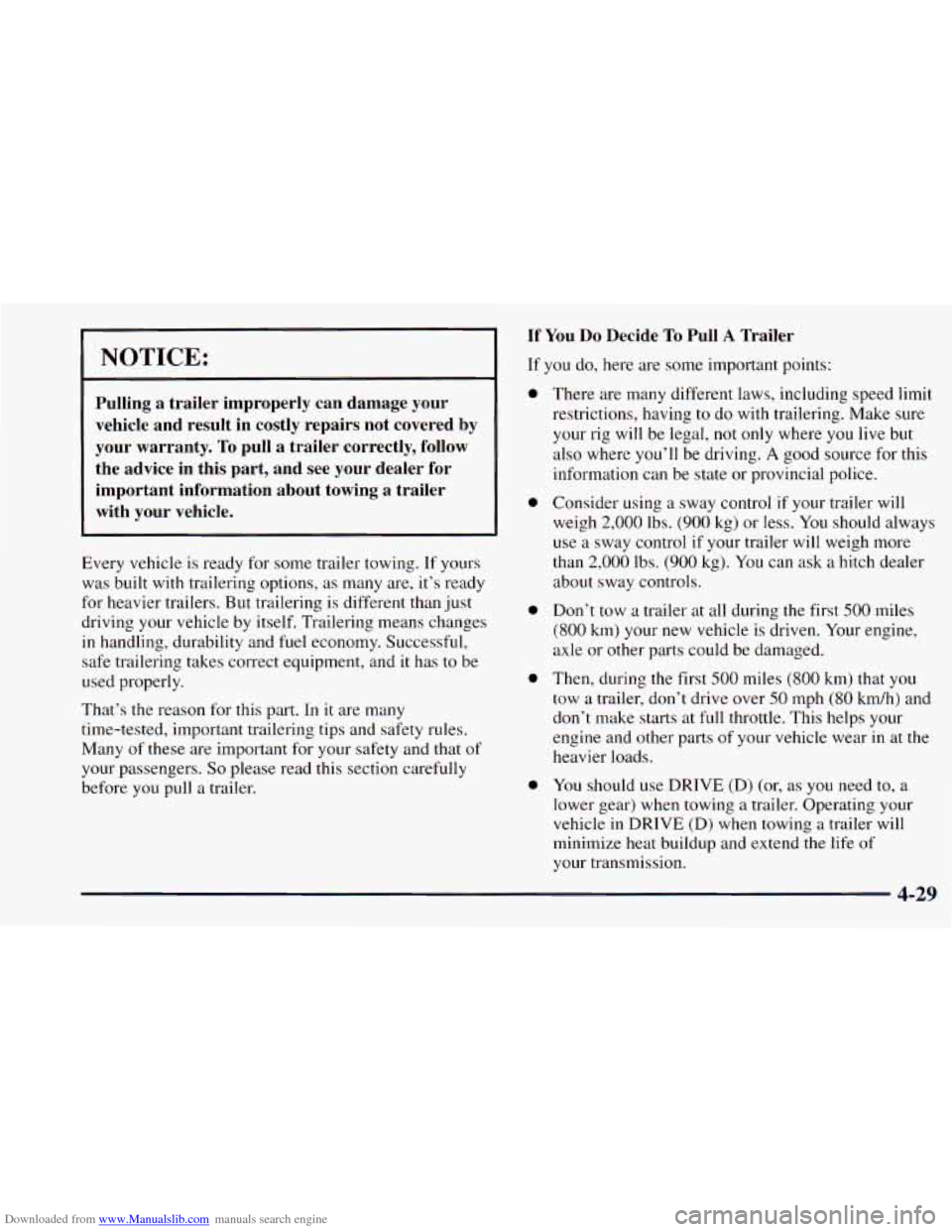
Downloaded from www.Manualslib.com manuals search engine NOTICE:
Pulling a trailer improperly can damage your vehicle and result in costly repairs not covered by
your warranty.
To pull a trailer correctly, follow
the advice in this part, and see your dealer for important information about towing a trailer
with your vehicle.
Every vehicle is ready for some trailer towing. If yours
was built with trailering options, as many are, it’s ready
for heavier trailers. But trailering is different than just
driving your vehicle by itself. Trailering means changes
in handling, durability and fuel economy. Successful,
safe trailering takes correct equipment, and it has to be
used properly.
That’s the reason for this part. In it are many
time-tested, important trailering tips and safety rules.
Many
of these are important for your safety and that of
your passengers.
So please read this section carefully
before
you pull a trailer.
If You Do Decide To Pull A Trailer
If you do, here are some important points:
a
a
a
a
a
There are many different laws, including speed limit
restrictions, having
to do with trailering. Make sure
your rig will be legal, not
only where you live but
also where you’ll be driving.
A good source for this
information can be state or provincial police.
Consider using
a sway control if your trailer will
weigh
2,000 lbs. (900 kg) or less. You should always
use a sway control if your trailer will weigh more
than
2,000 lbs. (900 kg). You can ask a hitch dealer
about sway controls.
Don’t tow
a trailer at all during the first 500 miles
(800 km) your new vehicle is driven. Your engine,
axle or other parts could be damaged.
Then, during the first
500 miles (800 km) that you
tow a trailer, don’t drive over 50 mph (80 kmh) and
don’t make starts at full throttle. This helps
your
engine and other parts of your vehicle wear in at the
heavier loads.
You should use DRIVE (D) (or, as
you need to, a
lower gear) when towing a trailer. Operating your
vehicle in DRIVE
(D) when towing a trailer will
minimize heat buildup and extend the life of
your transmission.
4-29
Page 219 of 414
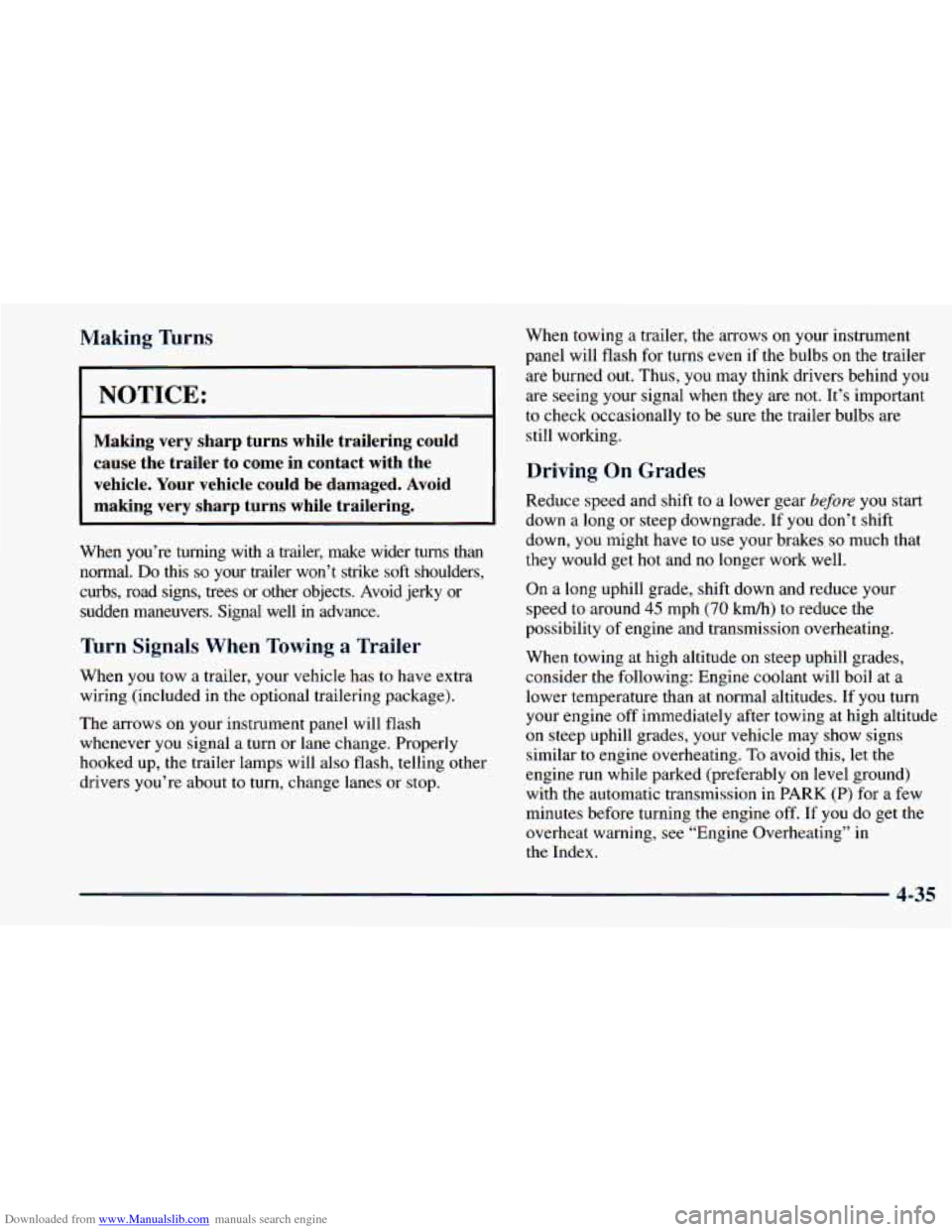
Downloaded from www.Manualslib.com manuals search engine Making Turns
NOTICE:
Making very sharp turns while trailering could cause the trailer
to come in contact with the
vehicle.
Your vehicle could be damaged. Avoid
making very sharp turns while trailering.
When you’re turning with a trailer, make wider turns than
normal. Do this so your trailer won’t strike soft shoulders,
curbs, road signs, trees or other objects. Avoid jerky or
sudden maneuvers. Signal well
in advance.
Turn Signals When Towing a Trailer
When you tow a trailer, your vehicle has to have extra
wiring (included in the optional trailering package).
The arrows on your instrument panel will flash
whenever you signal a turn or lane change. Properly
hooked
up, the trailer lamps
drivers you’re about to turn, will
also flash, telling other
change lanes or stop. When
towing a trailer, the arrows on your instrument
panel will flash
for turns even if the bulbs on the trailer
are burned out. Thus, you may think drivers behind you
are seeing your signal when they are not. It’s important
to check occasionally to be sure the trailer bulbs are
still working.
Driving On Grades
Reduce speed and shift to a lower gear before you start
down a long or steep downgrade. If you don’t shift
down, you might have to use your brakes
so much that
they would get hot and no longer work well.
On a long uphill grade, shift down and reduce your
speed
to around 45 mph (70 kdh) to reduce the
possibility of engine and transmission overheating.
When towing
at high altitude on steep uphill grades,
consider the following: Engine coolant will boil at a
lower temperature than at normal altitudes. If you turn
your engine off immediately after towing at high altitude
on steep uphill grades, your vehicle may show signs
similar to engine overheating.
To avoid this, let the
engine
run while parked (preferably on level ground)
with the automatic transmission in
PARK (P) for a few
minutes before turning the engine off. If you do get the
overheat warning, see “Engine Overheating” in
the Index.
4-35